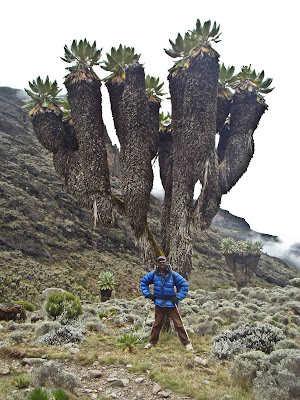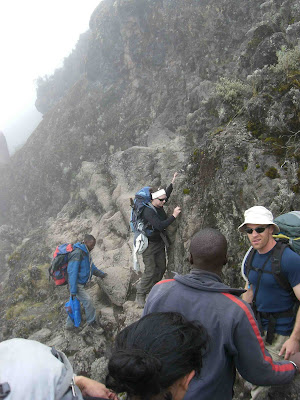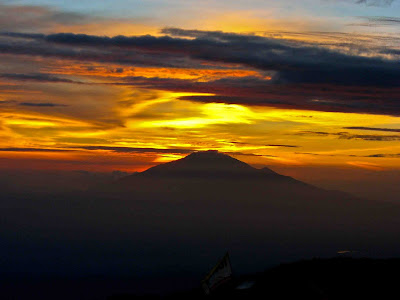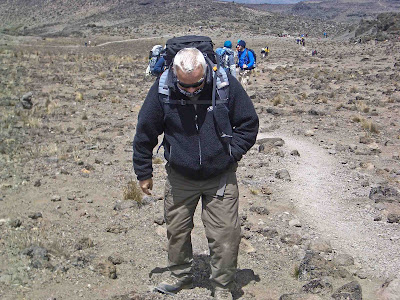Barafu Hut : 4600 m
Summit 1 : Stella : 5735 m
Summit 2 : Uhuru : 5896 m
Millenium Camp : 3800 m
Mwera Camp: 3200 m
Ascent : 1296 m
Descent : 2600 m
We were awoken at 11pm (still on day 6 really) and were told to get ready for the final assault. Our water bottles were filled with boiling water to try to prevent it from freezing on the ascent as it is liable to get down as far as minus 20 degrees on the summit (where Fahrenheit and centigrade are the same).
We were fed a light breakfast consisting of tea, biscuits and cake, following which we kitted ourselves out with the warm kit we had. The pace we were about to head off at was not going to keep us warm so our clothing had to.
The whole of Barafu Camp was alive with torches where people were stirring ready to get stuck into the culmination of what they had spent recent days working towards. At midnight we left the camp at a pace that would give us the best shot of climbing the 1300 metres we would need to do before we hit Uhuru - the summit of Kilimanjaro. Today we were guided by the head guide and three assistant guides along with the summit porter Patrick who brought the tea for our break at the crater rim.
One of our guides set the pace at the front of the pack as we left the camp, the only light being emitted from our head torches which you could see bobbing about everywhere from the different teams attempting the summit that morning.
Heading off at the steady pace we set was comfortable without any overheating. The pace we set I think was partly due to the darkness and the fact that we only had torchlight to guide our way which certainly made traversing the snow covered boulder field even more challenging, especially as our brains were only working at half pace at this altitude. To give an idea of how steady we trekked at this point, it took us around an hour to get out of the camp as we trudged ever upwards.
Once out of camp the boulders became fewer and farther between which did make it a touch easier but only due to the fact that the ground was more even, the steepness did not ease and anything but the steady trudge would have been reckless. We followed this path for around an hour and a half. There was nothing to see in the pitch black apart fro each others head torches and the circle of light our own head torch shone on the floor. It was important that we focused on the floor as there were still a lot of loose rocks, step on one of these and your balance is gone! This could enter you into a whole world of pain as you try to recover your balance or scrape yourself off the floor, either way this is precious energy and breath wasted that you need to regain and compose yourself from, something you really can do without.
At around 3am we reached the main ascent where the path starts to zig zag steeply all the way up the scree slope to the crater rim. This was no time to get excited, although we were now facing the final push it was an awfully long push.
It was snowing slightly at this time but will the layers and layers I had on, even at the slow slow pace we were ascending at my body was perfectly warm enough. My feet however were another matter they were in so much pain due to them being so exceptionally cold. I had two pairs of socks on and with no more socks with me the only solution my addled brain could come up with was to curl my toes up under themselves. This naturally wasn't the ideal solution and didn't make an awful lot of difference, however I wasn't suffering with the altitude sickness as some of the other guys were so this I felt was little really to worry about.
By about 4am there were no groups behind us and we had fallen to the very back of the pack. The idea of leaving in the middle of the night is to avoid climbing during daylight hours due to the fierceness of the sun at this altitude. Up here there is little atmosphere to filter out the UV rays so you burn in no time. The guides were now starting to get concerned about our pace and the fact that we were not going to be at the summit by daybreak. They were considering splitting the group into the faster and slower halves. The downside of this of course is that the slower guys become even slower without the motivation of staying on the heels of the quicker folk to keep them moving.

Having a breather on the ascent
That said we were certainly becoming slower as a group with us communally taking more and more breaks and sitting on whatever rock of ledge we could use as a makeshift seat to try to alleviate the muscle burn and to circulate oxygen throughout our bodies by gasping for air. Taking on fluids can really now only be done when stationary otherwise it is almost impossible to get your breath back.
At this point I did feel as though I still had plenty left in reserve but definitely better to keep it that way then overcook it and end up in the state I had done the previous day.

Mawenzi at first light
At around 6am we got the first hint that sunrise wasn't far away however we were probably still around 150 metres from the crater rim. We weren't that far behind schedule, the guides had judge our departure time from camp pretty well.

Mawenzi at sunrise
With the crater rim in sight the group separated to quite a large extent as those with energy left pushed whilst others were barely putting the heel of one foot in front of their other toes with each step. At around 6:30 as the sun was coming over the horizon with Stella Point now well and truly within reach I started to stride out now wanting to get there. I'd made it to Stella Point by about 7am which is the first point on the crater rim for all those routes approaching from the south and sits at an altitude of 5735 metres. There was still 160 metres to go to Uhuru, the summit of Kilimanjaro, and under normal circumstances this would be no mean fete however up here it is truly energy sapping. Patrick, the summit porter, arrived a the crater rim and provided us with tea as a morale booster and to ensure that we were not omitting to take on the vital fluids we needed.
At 8am the last of our team arrived at Stella Point and I felt for him, he looked as though he'd had it. The whole group shouted and screamed encouragement to boost his morale to get him to the crater rim. At which point he gave up, he was going no further. Or so he thought, but the guides had none of it and pushed him on for the top.

Glaciers close to the summit
This path flattened out quite a bit here as we walked around the crater rim passed all of the glaciers that we were advised had sadly been disappearing over the years. With the sun rising into the sky the temperature rose and layers had to be shed. One of the guys had a thermometer on his pack and we were amazed to hear that where we were expecting the temperature to be well below zero it was actually a fierce 15 degrees Celsius. No wonder the layers had to come off.

Glaciers close to the summit
Having walked around a third of the circumference of the crater I finally caught a glimpse of what I had been waiting to see for months, through all the training at home and throughout the previous 6 days on this mountain -Uhuru Peak at a height of 5895 metres. It is marked by the famous sign which marks the height and name of this beast, the highest mountain in Africa and the biggest free standing mountain in the world.

Me and my girlfriend Michelle at Uhuru Peak - woohoo
The feeling of euphoria was overwhelming and the views spectacular with the snow filled crater to one side and the colossal glaciers on the other decorated by frozen waterfalls as the ice melts during the day and freezes through the night. Fewer and fewer photographs were being taken in recent days as peoples enthusiasm to do anything other than trek wained. This however was one photograph that was not going to be missed. Job done I sat down to soak it all in when the strangest feeling washed over me. A combination of dizziness, overwhelming exhilaration and happiness I knew this was some kind of affect of the altitude. One of the guides saw it in me and told me it was time to go. I never argued and was straight up striding downhill back towards Stella Point.
We seemed to reach here in no time at all and once here there was no time to waste. We now had to descend to Mwera camp that was located at an altitude of 3100 metres that is a descent of 2.5 kilometres.
I had not been looking forward to this part of the trek, over the years my knees have had a fair amount of abuse with one thing and another so they were not going to enjoy this kind of torture. The scree just off the crater rim took a lot of the sting out of the impact which was great and we made great ground at a semi jog bouncing from one foot to the other.
Descending in the rain
Not far from the summit it started to snow and it fell heavily. That said this didn't slow anyone down and despite my knees feeling a touch tender we managed to get back to Barafu camp in just over 2 hours. It's crazy to think that it took me around seven hours to get up there and around two to get back.
Under normal circumstances we would enjoy a breather at Barafu Camp where we could have a bite to eat and a lie down however due to our poor time keeping on ascent this was not to be and we packed our bags from the night before, had a quick bite to eat and carried straight on through.
Over lunch the head guide gave us the opportunity to preen ourselves by advising us that in his 11 years as a guide we were only the second group that he'd successfully guided to the summit in it's entirety. This we put down wholly to the talent and attitudes of the guides.

Trying to keep our spirits high
With our bags packed we stepped back out into the relentless weather and descended Kilimanjaro further. The path fell through steep rocky terrain and with every step I was feeling a shooting pain through my joints which was starting to feel a bit like agony. This was a touch demoralising and although we had now completed our goal my morale was getting a touch low. This was to be compounded as the snow turned to hail as we descended then eventually to rain. I don't actually think you could refer to is as rain, it was far too heavy for that, either way the chips were down.
We appeared at Millenium Camp where we were supposed to be camping the night however as a thanks to the porters and guides we were pushing on to the lower camp in order that they could get an early start the following day and get home to the families they had not seen since we set foot on the mountain a week ago. Some of the guys stopped to by a bottle of pop that was on sale at the hut of the camp at exorbitant prices however the rest of us were cashless, I really didn't anticipate anywhere to spend it, but with entrepreneurial flare these days there is someone keen to sell you something wherever you may go.

Descending into the forest
As we descended from Millennium Camp the foliage became much greener and much fuller as we entered the tropical rain forest climate zone. There was still a lot of water around but it was so much warmer down here.
We finally stumbled into Mwera Camp late in the afternoon at around 5pm. We'd been trekking pretty much constantly for 17 hours with the last 5 hours being in what was snow all the way through to tropical rain, we'd ascended 1300 metres then descended 2600 metres and we were exhausted with aches on aches, but what a sense of achievement.
Being in the tropical climate zone meant most things were wet. Was I bothered? Was I hell! At this altitude breathing returned to normal, everyone could operate as humans should be able to and further more we had all achieved the goal we had all worked so hard for so long to do. With a huge sense of satisfaction and well bonded as a team we sat for our last meal on the mountain, potato soup, stew and fresh fruit. Everyone ate like they'd not eaten for a week - in fairness though some actually hadn't.
Soon after we hit the sack and I slept like a baby.







































